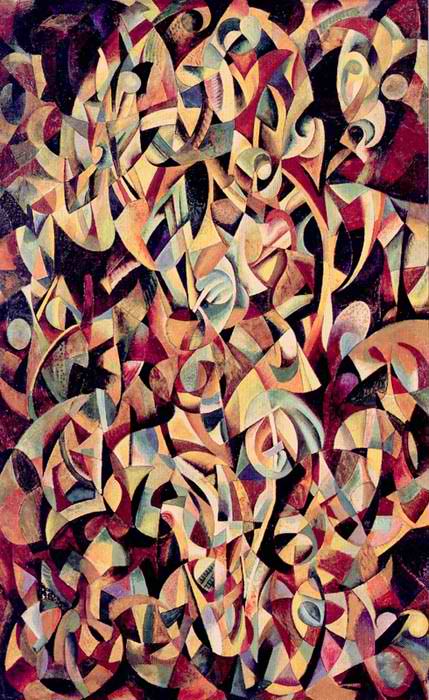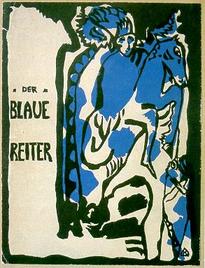|
Suprematism (art Movement)
Suprematism (russian: Супремати́зм) is an early twentieth-century art movement focused on the fundamentals of geometry (circles, squares, rectangles), painted in a limited range of colors. The term ''suprematism'' refers to an abstract art based upon "the supremacy of pure artistic feeling" rather than on visual depiction of objects. Founded by Russian artist Kazimir Malevich in 1913, Supremus (Russian language, Russian: Супремус) conceived of the artist as liberated from everything that pre-determined the ideal structure of life and art. Projecting that vision onto Cubism, which Malevich admired for its ability to deconstruct art, and in the process change its reference points of art, he led a group of Ukrainian and Russian avant-garde artists — including Aleksandra Ekster, Liubov Popova, Olga Rozanova, Ivan Kliun, Ivan Puni, Nadezhda Udaltsova, Nina Genke-Meller, Ksenia Boguslavskaya and others — in what's been described as the first attempt to independ ... [...More Info...] [...Related Items...] OR: [Wikipedia] [Google] [Baidu] |
Kazimir Malevich
Kazimir Severinovich Malevich ; german: Kasimir Malewitsch; pl, Kazimierz Malewicz; russian: Казими́р Севери́нович Мале́вич ; uk, Казимир Северинович Малевич, translit=Kazymyr Severynovych Malevych ., group=nb (Запись о рождении в метрической книге римско-католического костёла св. Александра в Киеве, 1879 год // ЦГИАК Украины, ф. 1268, оп. 1, д. 26, л. 13об—14. – 15 May 1935) was a ... [...More Info...] [...Related Items...] OR: [Wikipedia] [Google] [Baidu] |
Hugh Honour
Hugh Honour FRSL (26 September 1927 – 19 May 2016) was a British art historian, known for his writing partnership with John Fleming. Their ''A World History of Art'' (a.k.a. ''The Visual Arts: A History''), is now in its seventh edition and Honour's ''Chinoiserie: The Vision of Cathay'' (1961) first set the phenomenon of chinoiserie in its European cultural context. Early life Honour was born in Eastbourne, Sussex, to Herbert and Dorothy (Withers) Honour. After The King's School, Canterbury, he read English at St Catharine's College, Cambridge, graduating with a Bachelor of Arts degree. While at Cambridge, Honour met John Fleming, a solicitor and amateur art historian, who would become Honour's life partner. Honour accepted a position as Assistant director of Leeds City Art Gallery and Temple Newsam House but left after one year to join Fleming in Italy. Life in Italy Living in Asolo near Venice, Honour and Fleming began a highly productive writing and publishing partner ... [...More Info...] [...Related Items...] OR: [Wikipedia] [Google] [Baidu] |
Alexander Rodchenko
Aleksander Mikhailovich Rodchenko (russian: link=no, Алекса́ндр Миха́йлович Ро́дченко; – 3 December 1956) was a Russian and Soviet artist, sculptor, photographer, and graphic designer. He was one of the founders of constructivism and Russian design; he was married to the artist Varvara Stepanova. Rodchenko was one of the most versatile constructivist and productivist artists to emerge after the Russian Revolution. He worked as a painter and graphic designer before turning to photomontage and photography. His photography was socially engaged, formally innovative, and opposed to a painterly aesthetic. Concerned with the need for analytical-documentary photo series, he often shot his subjects from odd angles—usually high above or down below—to shock the viewer and to postpone recognition. He wrote: "One has to take several different shots of a subject, from different points of view and in different situations, as if one examined it in the round ... [...More Info...] [...Related Items...] OR: [Wikipedia] [Google] [Baidu] |
El Lissitzky
Lazar Markovich Lissitzky (russian: link=no, Ла́зарь Ма́ркович Лиси́цкий, ; – 30 December 1941), better known as El Lissitzky (russian: link=no, Эль Лиси́цкий; yi, על ליסיצקי), was a Russian artist, designer, photographer, typographer, polemicist and architect. He was an important figure of the Russian avant-garde, helping develop suprematism with his mentor, Kazimir Malevich, and designing numerous exhibition displays and propaganda works for the Soviet Union. His work greatly influenced the Bauhaus and constructivist movements, and he experimented with production techniques and stylistic devices that would go on to dominate 20th-century graphic design. Lissitzky's entire career was laced with the belief that the artist could be an agent for change, later summarized with his edict, "" (goal-oriented creation).Glazova Lissitzky, of Lithuanian Jewish оrigin, began his career illustrating Yiddish children's books in an effort to ... [...More Info...] [...Related Items...] OR: [Wikipedia] [Google] [Baidu] |
Constructivism (art)
Constructivism is an early twentieth-century art movement founded in 1915 by Vladimir Tatlin and Alexander Rodchenko. Abstract and austere, constructivist art aimed to reflect modern industrial society and urban space. The movement rejected decorative stylization in favor of the industrial assemblage of materials. Constructivists were in favour of art for propaganda and social purposes, and were associated with Soviet socialism, the Bolsheviks and the Russian avant-garde. Constructivist architecture and art had a great effect on modern art movements of the 20th century, influencing major trends such as the Bauhaus and De Stijl movements. Its influence was widespread, with major effects upon architecture, sculpture, graphic design, industrial design, theatre, film, dance, fashion and, to some extent, music. Beginnings Constructivism was a post-World War I development of Russian Futurism, and particularly of the 'counter reliefs' of Vladimir Tatlin, which had been exhi ... [...More Info...] [...Related Items...] OR: [Wikipedia] [Google] [Baidu] |
Monochrome
A monochrome or monochromatic image, object or palette is composed of one color (or values of one color). Images using only shades of grey are called grayscale (typically digital) or black-and-white (typically analog). In physics, monochromatic light refers to electromagnetic radiation that contains a narrow band of wavelengths, which is a distinct concept. Application Of an image, the term monochrome is usually taken to mean the same as black and white or, more likely, grayscale, but may also be used to refer to other combinations containing only tones of a single color, such as green-and-white or green-and-red. It may also refer to sepia displaying tones from light tan to dark brown or cyanotype ("blueprint") images, and early photographic methods such as daguerreotypes, ambrotypes, and tintypes, each of which may be used to produce a monochromatic image. In computing, monochrome has two meanings: *it may mean having only one color which is either on or off (also kno ... [...More Info...] [...Related Items...] OR: [Wikipedia] [Google] [Baidu] |
Polychrome
Polychrome is the "practice of decorating architectural elements, sculpture, etc., in a variety of colors." The term is used to refer to certain styles of architecture, pottery or sculpture in multiple colors. Ancient Egypt Colossal statue of Tutankhamun Paris 2019 A.jpg, Polychrome quartzite colossal statue of Tutankhamun, 1355-1315 BC Nofretete Neues Museum.jpg, Polychrome limestone and plaster ''Bust of Nefertiti'', 1352–1336 BC Composite Papyrus Capital MET 10.177.2 EGDP018080.jpg, Polychrome sandstone Composite papyrus capital, 380–343 BC Medinet Habu 2016-03-23g.jpg, Polychrome winged sun on a cavetto from the Medinet Habu temple complex, unknown date Classical world Some very early polychrome pottery has been excavated on Minoan Crete such as at the Bronze Age site of Phaistos. In ancient Greece sculptures were painted in strong colors. The paint was frequently limited to parts depicting clothing, hair, and so on, with the skin left in the natural c ... [...More Info...] [...Related Items...] OR: [Wikipedia] [Google] [Baidu] |
Modernism
Modernism is both a philosophical and arts movement that arose from broad transformations in Western society during the late 19th and early 20th centuries. The movement reflected a desire for the creation of new forms of art, philosophy, and social organization which reflected the newly emerging industrial world, including features such as urbanization, architecture, new technologies, and war. Artists attempted to depart from traditional forms of art, which they considered outdated or obsolete. The poet Ezra Pound's 1934 injunction to "Make it New" was the touchstone of the movement's approach. Modernist innovations included abstract art, the stream-of-consciousness novel, montage cinema, atonal and twelve-tone music, divisionist painting and modern architecture. Modernism explicitly rejected the ideology of realism and made use of the works of the past by the employment of reprise, incorporation, rewriting, recapitulation, revision and parody. Modernism also rej ... [...More Info...] [...Related Items...] OR: [Wikipedia] [Google] [Baidu] |
Folk Art
Folk art covers all forms of visual art made in the context of folk culture. Definitions vary, but generally the objects have practical utility of some kind, rather than being exclusively decorative. The makers of folk art are typically trained within a popular tradition, rather than in the fine art tradition of the culture. There is often overlap, or contested ground with 'naive art'. "Folk art" is not used in regard to traditional societies where ethnographic art continue to be made. The types of objects covered by the term "folk art" vary. The art form is categorised as "divergent... of cultural production ... comprehended by its usage in Europe, where the term originated, and in the United States, where it developed for the most part along very different lines." For a European perspective, Edward Lucie-Smith described it as "Unsophisticated art, both fine and applied, which is supposedly rooted in the collective awareness of simple people. The concept of folk art ... [...More Info...] [...Related Items...] OR: [Wikipedia] [Google] [Baidu] |
Cubo-futurism
Cubo-Futurism (also called Russian Futurism or Kubo-Futurizm) was an art movement that arose in early 20th century Russian Empire, defined by its amalgamation of the artistic elements found in Italian Futurism and French Analytical Cubism. Cubo-Futurism was the main school of painting and sculpture practiced by the Russian Futurists. In 1913, the term ‘Cubo-Futurism’ first came to describe works from members of the poetry group ‘Hylaeans’, as they moved away from poetic Symbolism towards Futurism and ''zaum'', the experimental “visual and sound poetry of Kruchenykh and Khlebninkov”. Later in the same year the concept and style of ‘Cubo-Futurism’ became synonymous with the works of artists within Ukrainian and Russian post-revolutionary avant-garde circles as they interrogated non-representational art through the fragmentation and displacement of traditional forms, lines, viewpoints, colours, and textures within their pieces. The impact of Cubo-Futurism was then ... [...More Info...] [...Related Items...] OR: [Wikipedia] [Google] [Baidu] |
Der Blaue Reiter
''Der Blaue Reiter'' (The Blue Rider) is a designation by Wassily Kandinsky and Franz Marc for their exhibition and publication activities, in which both artists acted as sole editors in the almanac of the same name, first published in mid-May 1912. The editorial team organized two exhibitions in Munich in 1911 and 1912 to demonstrate their art-theoretical ideas based on the works of art exhibited. Travelling exhibitions in German and other European cities followed. The Blue Rider disbanded at the start of World War I in 1914. The artists associated with ''Der Blaue Reiter'' were important pioneers of modern art of the 20th century; they formed a loose network of relationships, but not an art group in the narrower sense like '' Die Brücke'' (The Bridge) in Dresden. The work of the affiliated artists is assigned to German Expressionism. History The forerunner of The Blue Rider was the Neue Künstlervereinigung München (N.K.V.M; New Artists' Association Munich), instiga ... [...More Info...] [...Related Items...] OR: [Wikipedia] [Google] [Baidu] |
Donkey's Tail
Donkey's Tail (, Romanized: Osliniy khvost) was a Russian artistic group created from the most radical members of the Jack of Diamonds group. The group included such painters as: Mikhail Larionov (inventor of the name), Natalia Goncharova, Kazimir Malevich, Marc Chagall, and Aleksandr Shevchenko. The group, according to Gino Severini in his autobiography, was Futurist; it is known that, even if they were not, they were certainly influenced by the Cubo-Futurism movement. The only exhibition of the group took place in Moscow in 1912 (notable for being the start of Malevich's entry into his Cubo-Futurist phase), and in 1913, the group fell apart. Gallery File:Cyclist (Goncharova, 1913).jpg, Natalia Goncharova, ''Cyclist'', 1913 File:Chagall IandTheVillage.jpg, Marc Chagall, ''I and the Village ''I and the Village'' is an oil-on-canvas painting by the Belarusian-French artist Marc Chagall created in 1911. It is exhibited at the Museum of Modern Art, New York. [...More Info...] [...Related Items...] OR: [Wikipedia] [Google] [Baidu] |



.jpg)




.jpg)
.jpg)
